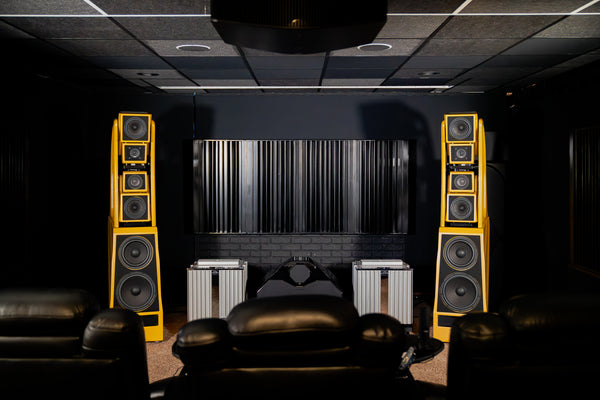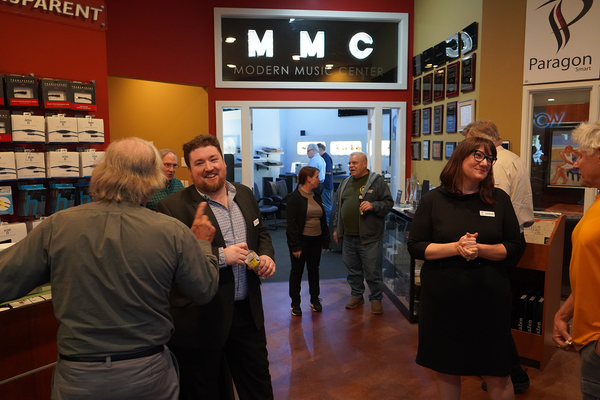
Featured Partner: Convergent Sound Treatments
If you have a difficult room that can't seem to be effectively transformed into a multimedia space, don’t give up hope: Christian Maloof has solutions.
Convergent Sound Treatments is our preferred partner for customized room treatments, both Paragon’s showroom and our client system installations. President/Owner Christian Maloof, an avid audiophile himself, began designing room treatments for his own home system before introducing his products to Paragon. The work was so outstanding that we started bringing him into our customer installations to fantastic results and very high client satisfaction.
Convergent Sound Treatments' work in Paragon's Audition Room 1, 2022
Christian is also a builder by trade, and as such, he understands the importance of working with architects and designers to integrate room treatments seamlessly. Convergent Sound Treatments can work with your team to create cohesive, subtle aesthetics that don't detract from the architecture of your home.
We sat down with Christian about his background in construction, clear up some misconceptions about sound treatments, and at the impressively in-depth process CST undergoes for each project. It was an absolute blast to pick his brain about this complex subject.

What is the most common misconception you hear from clients about room treatments?
Christian Maloof: Some customers believe treatments can detract from the aesthetic of the listening room. Room treatments do not have to be ugly. Our quadratic diffusers, for example, can be painted custom colors to match walls or trim. We also offer them in fine wood finishes like oak, cherry, or walnut. While bass traps inherently need to be bigger (deeper in particular), we combine materials and technology to reduce their footprint and volume.
What is a quadratic diffuser?
A diffuser, unlike an absorber, offers a smoother and more energy efficient response to reverberation and reflection. Absorption, although very useful and an important tool, will inherently reduce the energy in the room. Too much absorption can take the “life” out of your music.
Can you walk us through the high-level process of treating a room for a customer, from scoping a room to implementation & building?
CM: Certainly!
Step 1: Initial consultation
First we meet with the client to understand their desired outcome.
Step 2: Walkthrough
The next step is to schedule a walkthrough of the space to understand the room’s needs, beginning with both a physical measurement and a Lidar scan of the room. A full Lidar scan allows us to build a full 3D model so we can plan around framing, mechanicals as well as other room boundaries.
After acquiring a detailed plan view, 3D models, and test plan, we run frequency sweeps to identify target locations for treatments.
Step 3: Custom report
We provide the client with a comprehensive report of the testing results as well as our recommendations. Included in the report is a model of the client’s space, illustrating the specific room treatments that will be used as well as their room placement. We can provide full-scale rendered space including windows, doors, electronics, and speakers.
Step 4: Building & installation begins!
Step 5: Acoustical Review and Sound Treatment Assessment
After the installation is complete, Convergent returns to the space to test & measure performance to ensure objective upgrades have been made. The results can be in a report and provided to the client.
Most applications feature the ability to change out treatments if future changes occur to the system.
Could you briefly discuss some of the unique challenges of some of your recent work on Paragon client installations?
CM: Each room presents a unique challenge to music reproduction. One of the most common is the ceiling boundary like the above room. When compared to room lengths or widths, a typical 8’ ceiling is quite close. When this is the case, we like to use absorption to mitigate room modes in critical frequencies.
"I don’t know how I listened to my room before. This has been the best investment or upgrade in my hifi ever." -- Client feedback, above system
The side boundary in this room was quite close, so it required not only significant diffusion to improve image width, depth and stability, but the addition of absorption to help the upper-low bass punch. This was also a dual-purpose room with an incredible reference theater. It CAN be done and done well.
Let's switch gears and talk a little bit about you. How did you get started doing sound treatments for home audio systems?
CM: I have always had a passion for music. Whether it was my bumpin’ car stereo in the 90’s or my first high-end Sony Walkman with separate power supply, I spent a good deal of my day listening to music.
In a college physics class, I focused on the physics of sound. Fast-forward 30 years and several components and systems later, I combined the forces of Watermark’s custom carpentry side with my love for music and math, and I set out to make my own room treatments. I already had reference-level equipment, but I wanted to improve my room and get closer to what I knew was possible.
How did you go from working on Paragon's audition rooms to being brought on as a partner on Paragon customer installations?
CM: Like most of my life, there’s always a story. I experimented on my own for several years. My company, Watermark Building & Custom Carpentry, has built several sound rooms and home theaters, but we typically bought acoustical treatments “off the shelf.” The treatments helped but it was time to take the same custom approach we had to building bespoke homes to high end sound treatments.
After a few versions I was already making a good deal of progress. I challenged Paragon owner Larry Marcus to allow me to bring some of my prototypes into his personal, newly built sound room to let him experience the dramatic difference. In that first very long night, and with the help of his wife Dawn, we set up blind auditions for Larry’s finely tuned ear. The ending, much like many high-end auditions, resulted in me leaving our treatments in his home.

Larry Marcus (right) & Christian Maloof
Two months and several listening sessions later we installed custom stained units in cherry. Over that time Larry’s excitement to bring this level of custom room treatments grew and the logical partnership between Paragon and Convergent was born.
- - -
To learn more about Convergent Sound Treatments, visit their website.
To connect with Paragon & Convergent on a new or existing system in your home, contact us to set up a consultation.


